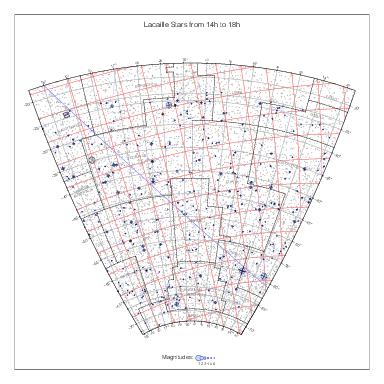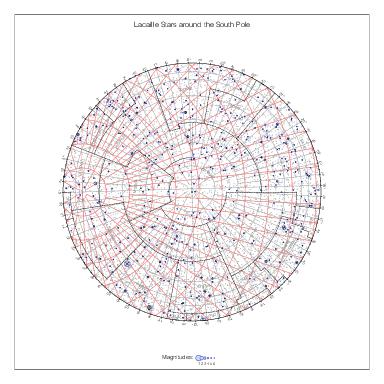This page presents star maps that illustrate Lacaille's star catalog from Coelum Australe Stelliferum (the previous page has explanations).
Planisphere
The first map below represents the whole sky south of the tropic of Capricorn and all the lettered stars from Lacaille's catalog, similarly to the planispheres found at the end of [CA] and [EA] (a nice high definition reproduction of the one in [CA] can be found here). Instead of the constellation figures, the map shows the modern constellation boundaries precessed to the 1750 equinox. It shows all the lettered stars from [CA], while the planispheres only show the brightest ones. A detailed comparison reveals a few erroneous or misplaced letters in the planisphere.
Coelum Australe
|
The maps take into account a few corrections to the letter assignments in [CA], described in more detail in the file lac_notes.dat, according to the following table. In these cases, the star and the label are drawn in red.
| CA # | Issue |
|---|---|
| 261 | is χ For instead of 263 |
| 294 | is τ Eri |
| 493 | is δ Pic instead of 495 |
| 513 | has lost η Dor because it doesn't exist |
| 556 | is N Car instead of 555 which doesn't exist |
| 996 | is β Ant rather than η Ant |
| 1376 | is β Nor, omitted from CA |
| 1377 | is τ Sco, omitted from CA |
Coelum Australe Maps
The seven maps below cover the sky south of the tropic of Capricorn and show all the stars from Lacaille's catalog in [CA], with their CA numbers and letter assignments by Lacaille (corrected as just described). Lacaille's stars are drawn as blue disks with a solid border and his nebulous objects as blue disks with a dotted border and fixed radius (corresponding to the arbitrary magnitude value 4).
All the stars from the Hipparcos catalog up to magnitude 9.0 (or fainter if they correspond to a Lacaille star, which happens only for a handful of secondary components) are represented by + crosses, at their positions adjusted to the 1750 epoch and equinox. In the rare cases where Lacaille's position differs noticeably, a blue line connects the Lacaille star to its corresponding Hipparcos star.
Additional reference stars from the SAO and Henry Draper catalogs are represented when they are associated with a Lacaille star and have no counterpart in the Hipparcos catalog. SAO stars are drawn as 3-point asterisks, and Henry Draper stars as x crosses, at their respective catalog's positions adjusted to 1750.
| 18h to 22h | 14h to 18h | 10h to 14h | 6h to 10h | 2h to 6h | 22h to 2h | |

|

|

|

|

|

|
-70° to -20° |
| 18h to 22h | 14h to 18h | 10h to 14h | 6h to 10h | 2h to 6h | 22h to 2h | |

South Pole |
-90° to -65° | |||||
The maps are too dense to look presentable on letter-size paper. They are meant to be looked at and zoomed in on a (preferably large) monitor.


